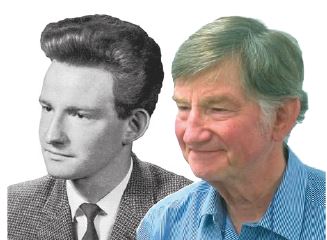
Physiology News Magazine
Editorial: An ageing new editor
News and Views
Editorial: An ageing new editor
News and Views
Roger Thomas
Editor, Physiology News

https://doi.org/10.36866/pn.98.5
This issue is my first as Editor, and is coincidentally focused on ageing. The photographs above show the effects of the passage of 50 years on my own appearance. The black and white photo is from 1964, the colour one from 2015. I myself remain impressed and surprised at my appointment. Although I have been a contributor to The Physiological Society Magazine and its successor, Physiology News, since the first number, I believe it could be improved going forward. Or perhaps backwards. I told the appointment panel when they interviewed me on 4 February that my intention was, with the help of the Editorial Board and the Managing Editor (Helen Burgess) to make the magazine essential reading for all members of the Society.
I suggested that PN needs more about the various HHH staff members’ activities, what was discussed at committee meetings etc. Meeting Notes should be expanded. Research reports should be addressed more clearly at a wide readership and should have more subheadings and fewer histograms. Teachers should be able to update their lectures with help from experts. Readers who want more should be directed more clearly to the key papers. Theme leads should be asked to suggest or provide material. I now ask all members to please contact me at magazine@physoc.org with any ideas for articles they might write, cartoons they might draw, and jokes they might pass on. I plan to have ‘Letters to the Editor’ as in the past. Perhaps departmental profiles or news of moves by members.
So how did I start on a career which has, I hope, been crowned by this Editorship? I was first attracted to a research career by a visit in about 1955 to an open day at the local University’s physics department. I still remember the infectious enthusiasm of the research students operating a cloud chamber detecting subatomic particles. My own first steps on a physiological career started when I was an undergraduate at Southampton University reading Zoology. (I was rejected by Bristol, and could only go to Cambridge if I did two years’ military service first. But it was soon to be abolished.) As I recall we had to take two other ‘subsidiary’ subjects in our first year, Chemistry and one other. I chose ‘Physiology and Biochemistry’ as taught by a new department with only four academic staff, headed by Ken Munday.
I found this subject to be far the most interesting of the three, particularly the witty lectures given by Gerald Kerkut. As an Honours Zoologist, I had to plead to be allowed to change subjects. I was allowed to switch as long as I performed well in the end of year exams. I was not influenced by the fact that the four female P and B students were much more attractive than the Zoologists. So I ended up in 1961 with a BSc and a determination to be a research student. Having been rejected by labs in Australia and the USA, I accepted a NATO research studentship to work under Kerkut’s supervision. Three years later my thesis on acetylcholine and IPSPs in snail neurones was accepted; I married my fiancée, and obtained a post-doc position in New York, salary $7,000.
I obtained this thanks entirely to a letter Kerkut wrote to Victor Wilson, whom he had known at Cambridge. With no action on my part, not even filling in a form, I shortly received a letter from the Rockefeller Institute offering me a job in Wilson’s lab with a requirement to teach a short course in neurobiology, including two lab classes. Most of the time I helped research into Renshaw Cells, and motoneurones in the cat CNS. Success in marking the position of the tip of an extracellular glass microelectrode with Fast Green led to our first paper in Nature.
After one year (on an immigrant visa) I had to register for the US draft. Very ironic. I was passed medically fit, but if called up I resolved to depart for Canada immediately. After two years we decided to return to the UK, and after some letter-writing I became a post-doc in EJ Harris’s lab at UCL. This was in the Biophysics Department, chaired by Bernard Katz, who had been the external examiner for my PhD. After two years working on snail neurone sodium pumps essentially by myself, and not assisting EJ at all, Katz told me I really had to do what EJ wanted. I must have been a dreadful post-doc. For my last year I worked on calcium uptake by rat liver mitochondria, using pH and potassium-sensitive mini-electrodes and the calcium dye murexide. During that last year I was appointed to a lectureship in Physiology at the University of Bristol and also became a member of the Physiological Society. In 1996 I moved to Cambridge, where I am still involved in the department of PDN. I have plenty of spare time for editing.
